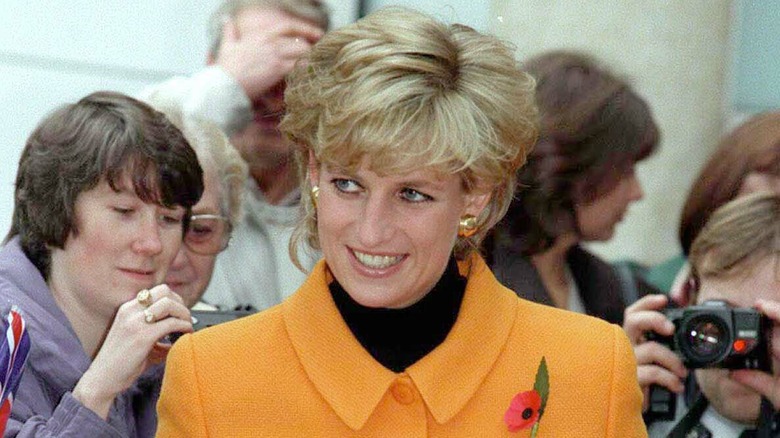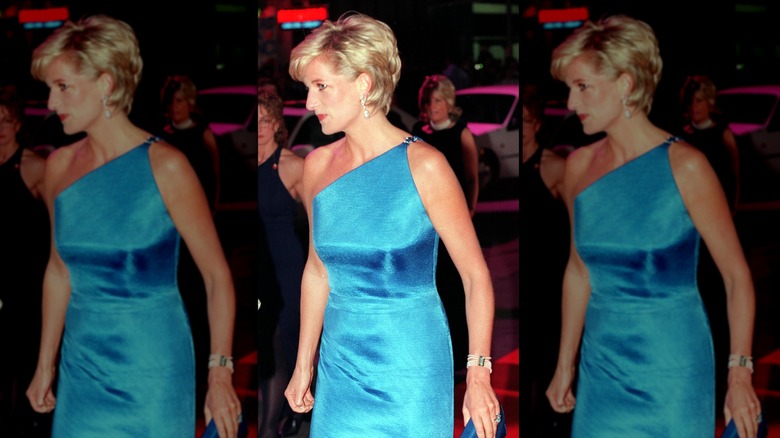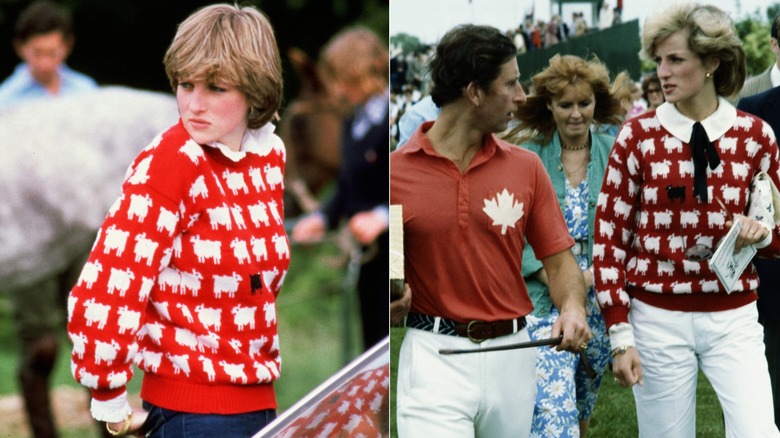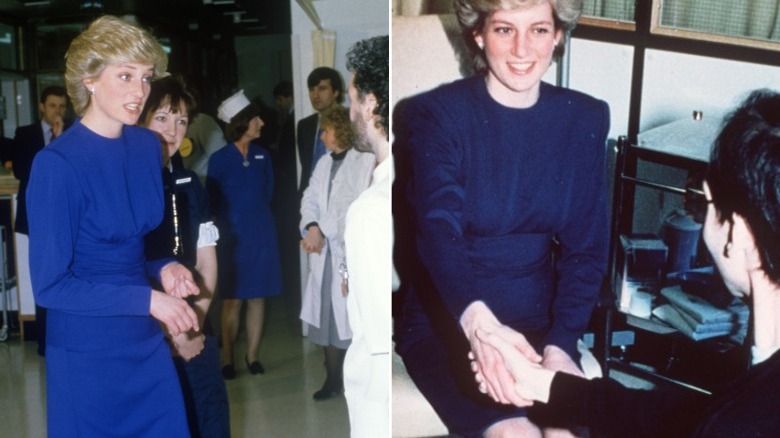How Princess Diana Used Her Street Style To Send A Message To The Royal Family
There's no shortage of fictional pop culture style icons you should let influence your wardrobe, but if you'd like to take fashion inspiration from a real person, look no further than the late Princess Diana. An unstoppable force in the 1980s and 1990s, the People's Princess had several big claims to fame. While the rest of the world still mourns a humanitarian royal, those of us in the fashion space consider Diana a sartorial legend. Her clothes didn't just look good either; they told a story. "What really set Diana apart was her ability to communicate with her clothing," Eleri Lynn, curator of the "Diana: Her Fashion Story" exhibition, pointed out to Vanity Fair in 2017. "It is very surprising how little footage there exists of the Princess actually speaking. We all have a sense of what we think she was like, and yet so much of it comes from still photographs, and a large part of that [idea] is communicated through the different clothes that she wore."
While she may have spoken to the world through her wardrobe, the beloved royal frequently seemed to be sending messages to her in-laws in particular. Princess Diana's notorious revenge dress became one of the most iconic looks in fashion history, firmly telling then-Prince Charles that he could eat his heart out after confessing to an affair during their marriage, with now-wife Camilla Parker Bowles. She certainly had multiple nighttime and formal looks that turned heads while simultaneously calling out The Firm, but her street style may have been even more powerful in sending a message. Through deliberate moves like deviating from British designers and even abandoning traditional royal garb, Diana was able to say what words couldn't.
Princess Diana chose trendy over traditional, highlighting her rebellious nature
Though she was so softly spoken the press initially referred to her as "Shy Di," Princess Diana turned out to be the biggest rebel of the century, in royal terms. Following the dissolution of her marriage to then-Prince Charles, she began to dress in a slightly edgier style, embracing lower necklines and shorter hemlines. But hints of this bold approach came through earlier on too. Once Diana was part of the royal family, she began opting for trendier clothes instead of pieces that were more traditional, embracing the biggest crazes of the 1980s and the early 1990s.
Rather than blindly following the masses, Diana welcomed the trends that flattered her, taking such a liking to them that the princess became synonymous with padded shoulders and masculine, oversized silhouettes typically never worn by other royal family members. Adopting a modern aesthetic may not seem like a rebel move now, but at the time, it marked a major departure from what had been seen in both royal and aristocratic circles for centuries. As designer Jack L. Carlson proclaimed, "Her style was so very much her own," (via CNN).
He elaborated, "She was not a follower. To the contrary, she did her own thing, and we all watched in wonder and tried to keep up." This likely made it clear to both The Firm, and the millions of fans watching all over the world, that Diana was her own person, who was carving out a new identity for the more than 700-year-old Princess of Wales title. But Diana's desire to freshen up royal style likely didn't come as too much of a surprise for those at Kensington Palace since she was also famously the first to choose her engagement ring from a catalog.
Princess Diana made her star power clear with her strategic wardrobe choices
Not only did Princess Diana embrace the key trends of the time, but she quickly learned what did and didn't work for her, and stuck exclusively to looks that helped her stand out. She's since been immortalized as the People's Princess, but Diana's star power was apparent even before her untimely death. Part of this naturally came from her warmth and empathy for others, but it would be remiss not to attribute at least some of that universal appeal to her wardrobe. When she first stepped onto the world stage, Diana often wore frilly, matronly pieces that likely contributed to that initial "Shy Di" title. But as time went on, she ditched the smocks and collars for pieces that had more dazzle, and expert Eleri Lynn believes this was entirely intentional.
"You really see the frills and the ruffles of her early romantic style disappearing quite quickly, as she realized that didn't work very well for press photographs," Lynn shared with Vanity Fair. "It made her look cluttered. So around the '80s you see the silhouette sleek down, and all the decoration becomes surface embellishment." While sleeker style choices let the world know Diana was the star of the show, the royal family also got the message loud and clear.
"She was outshining whatever Charles was doing and other members of the royal family too," journalist, and royal expert, Richard Kay argued during an interview with CNN. "Diana was in no doubt that it was Prince Charles' office officials who were out to downgrade her. She was perceived as a threat to them because her publicity was generally greater and more effective than Prince Charles' and Charles was the heir to the throne."
Princess Diana broke up with British designers after her divorce
Even today, the nationality of a clothing designer or fashion house is paramount to royal and political women. For example, the stunning style transformation of Kate Middleton exemplified the Princess of Wales' preference for British designers like Catherine Walker and Alexander McQueen, though she frequently dons international labels when visiting their countries too. Initially, Princess Diana leaned heavily towards U.K.-based designers, including having Welsh duo Elizabeth and David Emanuel tackle her iconic wedding dress. Catherine Walker was also a frequent collaborator, and who could forget the Bellville Sassoon gown she wore while having a snooze during a 1981 exhibition at London's Victoria and Albert Museum?
But Princess Diana's style started to change once she left the royal family. Following her high-profile divorce, the beloved royal started to adopt an increasing number of non-British designers into her rotation, perhaps sending a message to her ex that she was no longer bound by strict royal rules — not that it ever stopped her before, of course. After separating from then-Prince Charles in 1992, Diana was typically spotted in the likes of the American designer Ralph Lauren, Italians like Salvatore Ferragamo and Versace, and iconic French label Chanel.
She also developed a close, and rather fruitful, relationship with Christian Dior, whose Chouchou bag Diana loved so much the brand actually renamed it Lady Dior. But she didn't totally turn her back on her favorite British designers, continuing to sport several memorable Catherine Walker numbers. They served as some of Princess Diana's leggiest looks since leaving the royal family.
Princess Diana's iconic black sheep sweater was very telling
Princess Diana's fashion seemed to get louder and louder as the years went on and she really came into her own, but some of the dedicated humanitarian's earlier fashion choices also conveyed strong messages to the royal family. One of her most famous pieces — which was far from the most glamorous — was Diana's iconic black sheep sweater. It was designed by Sally Muir and Joanna Osborne, of Warm & Wonderful, and featured several rows of sheep on a red background. All sheep but one were white, which made the single black one stand out like a sore thumb. The sweater led to years of speculation, but royal and Diana experts alike tend to agree that the knitwear painted a clear picture of how she felt at the time.
It's widely believed that she was trying to tell her royal circle that she was the odd one out. "I don't think many people want me to be queen," Diana admitted to Martin Bashir during an explosive interview with the BBC's "Newsnight" in 1995, which has since become infamous (via YouTube). "Actually, when I say many people, I mean the establishment that I'm married into. Because they've decided I'm a non-starter [...] because I do things differently. Because I don't go by a rule book [...] They see me as a threat of some kind." She first donned the sweater to attend a polo match in 1981 but was seen again in another version of it in 1983. It became so iconic that the original sweater fetched more than $1 million at auction in 2023.
Princess Diana spoke volumes about her priorities by abandoning her gloves
Princess Diana deviated from royal norms in many notable ways, but one of the most famous examples was her decision to stop wearing gloves during official engagements. It was unheard of at the time for royal women to be glove-free when meeting members of the public, but Diana was a pioneer in this space, and as usual, there was likely a deeper meaning behind the move. "One of her most famous gestures [was] to remove her gloves very conspicuously to hold hands with patients — you know she's using clothing and fashion in order to really hammer home that message [of empathy]," Eleri Lynn asserted during her 2017 chat with Vanity Fair. This sent a particularly strong message in 1987 when Diana met with AIDS patients at the Middlesex Hospital and gladly shook their hands without wearing gloves.
At the time, it wasn't clearly understood that AIDS is not passed from person to person through touching hands, so the princess made a statement by going without gloves — and it wasn't the first time she adjusted her wardrobe for the sake of the people around her either. "[She wore] cheerful, colourful clothes, because she wanted to convey approachability and warmth," Lynn went on. "She would sometimes wear chunky jewellery so that children could play with it, and she never wore hats to children's hospitals after a while, because she said you couldn't cuddle a child in a hat [...] If she was visiting hospitals for the blind, she would often wear velvet so that she would feel sort of warm and tactile." These subtle fashion moves will be remembered forever, alongside her endless compassion, both of which let the royal family know Diana was happy to abandon The Firm's strict rules in the name of humanity.





